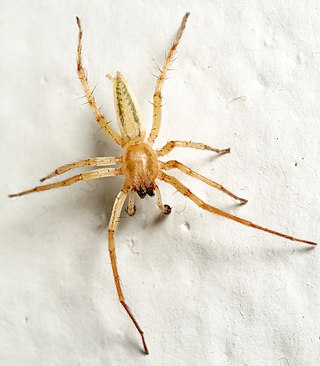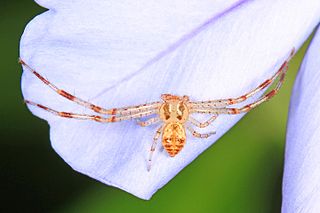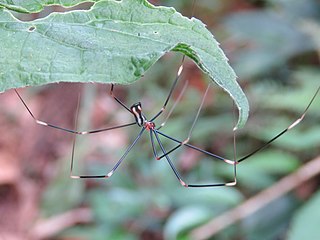
Anyphaenidae is a family of araneomorph spiders, sometimes called anyphaenid sac spiders. They are distinguished from the sac spiders of the family Clubionidae and other spiders by having the abdominal spiracle placed one third to one half of the way anterior to the spinnerets toward the epigastric furrow on the underside of the abdomen. In most spiders the spiracle is just anterior to the spinnerets. Like clubionids, anyphaenids have eight eyes arranged in two rows, conical anterior spinnerets and are wandering predators that build silken retreats, or sacs, usually on plant terminals, between leaves, under bark or under rocks. There are more than 600 species in over 50 genera worldwide.

Misumena is a genus of crab spiders sometimes referred to as flower crab spiders. They are similar in appearance to several other genera in the family Thomisidae, such as Misumenoides and Mecaphesa.

Misumenops is a common genus of crab spider with more than 50 described species.

Castianeira is a genus of ant-like corinnid sac spiders first described by Eugen von Keyserling in 1879. They are found in Eurasia, Africa, and the Americas, but are absent from Australia. Twenty-six species are native to North America, and at least twice as many are native to Mexico and Central America.

Lycosa is a genus of wolf spiders distributed throughout most of the world. Sometimes called the "true tarantula", though not closely related to the spiders most commonly called tarantulas today, Lycosa spp. can be distinguished from common wolf spiders by their relatively large size. This genus includes the European Lycosa tarantula, which was once associated with tarantism, a dubious affliction whose symptoms included shaking, cold sweats, and a high fever, asserted to be curable only by the traditional tarantella dance. No scientific substantiation of that myth is known; the venom of Lycosa spiders is generally not harmful.

Micrathena, known as spiny orbweavers, is a genus of orb-weaver spiders first described by Carl Jakob Sundevall in 1833. Micrathena contains more than a hundred species, most of them Neotropical woodland-dwelling species. The name is derived from the Greek "micro", meaning "small", and the goddess Athena.

Tmarus is a genus of crab spiders, comprising 227 species:
Camillina is a genus of ground spiders that was first described by Lucien Berland in 1919. They are very similar to sister genus Zelotes.
Sanogasta is a genus of South American anyphaenid sac spiders first described by Cândido Firmino de Mello-Leitão in 1941.

Olios is the largest genus of huntsman spiders, containing 166 species. They are found throughout the world, with most species occurring in hot countries. The genus was first described by Charles Athanase Walckenaer in 1837.

Mastophora, also known as bolas spiders, is a genus of orb-weaver spiders first described by E. L. Holmberg in 1876. They can be identified by a pair of lumps on the dorsal surface of the opisthosoma, though not all males will have these lumps.

Metaltella is a genus of South American intertidal spiders first described by Cândido Firmino de Mello-Leitão in 1931. One species, Metaltella simoni, has been introduced to North America.

Eustala is a genus of orb-weaver spiders first described by Eugène Simon in 1895.

Polybetes is a genus of South American huntsman spiders that was first described by Eugène Louis Simon in 1897. It is a senior synonym of Leptosparassus and Streptaedoea.

Mesabolivar is a genus of cellar spiders that was first described by M. A. González-Sponga in 1998.

Xenoctenidae is a family of araneomorph spiders separated from Miturgidae in 2017.













